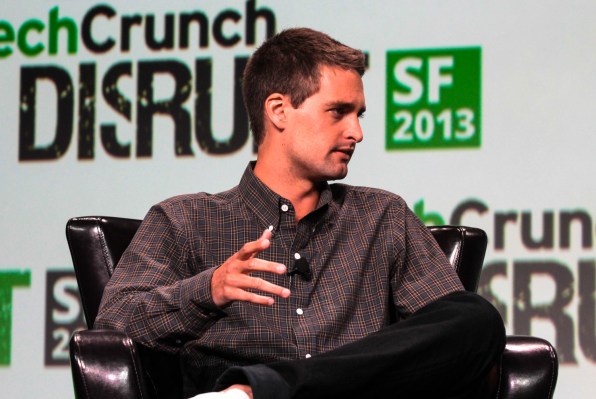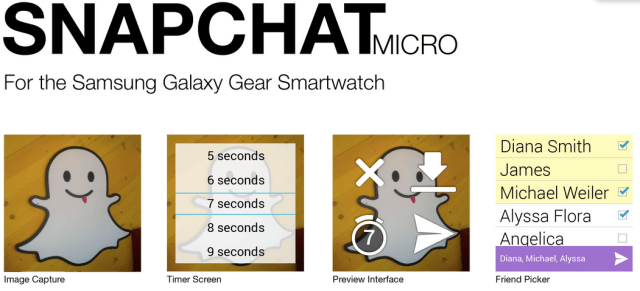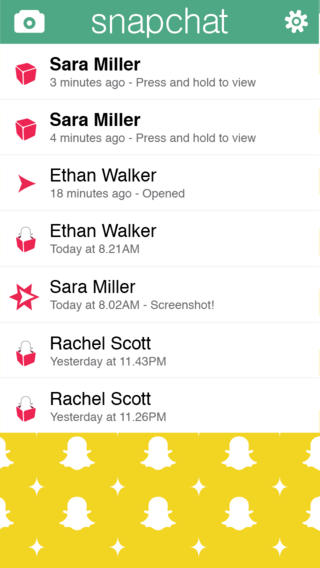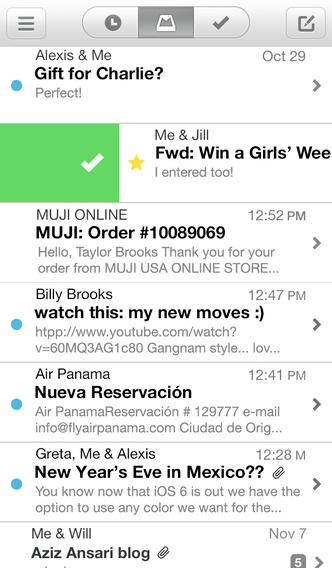Snapchat co-founder and CEO Evan Spiegel took the stage today at TechCrunch Disrupt and dropped a number of hints about Snapchat’s future products, from wearable tech to social media feeds.
What’s particularly interesting is how successful Snapchat has been as a product (Spiegel announced today that users send 350 million photos per day on Snapchat, a 1,750% increase in daily photos in less than a year) while Snapchat the company is really still in phase one.
Wearables
Spiegel noted that wearable technology is interesting to Snapchat and is “something we’ll continue to explore with a wide variety of products.”
He says the company is not currently working on, or even considering building an app for Google Glass. Spiegel told our own Jordan Crook that he thinks Glass is “invasive,” and sometimes feels like “a gun pointed at you.”
This is an interesting contradiction for the company. Snapchat has always been about capturing and sharing moments with your friends in real time. Presumably, there would be no better tool than Google Glass to capture and share exactly what you’re seeing. But at the same time, the app has always been about privacy and intimate moments. On stage, Spiegel suggested a recording light for Glass so that people know when they’re being recorded.
The company has already released Snapchat Micro, an app for the Samsung Galaxy Gear smart watch.
“One of the key parts of our service is reducing that amount of time between seeing something that you really want to share and being able to share it,” Spiegel said. “We really found playing with the prototypes of the watch that it was really fun and easy to just be able to grab it on the watch…there was a lot of delight that that was two seconds instead of seven.”
Speed is huge for Snapchat. The company has a patent, “Single mode visual media capture,” on its technology allowing users to take a picture by tapping the camera button and a video by holding down the same camera button. This technology, and the app always opening right to the record screen, lets users grab moments very quickly.
Digital Dualism
Spiegel spoke about how he thinks too much technology to date has kept the digital and analog worlds separate, and how Snapchat aims to better bridge the real world and digital world.
“It turns out that video chat is kind of lame because the connection breaks up, when you really could leverage all of these great aspects of the digital world,” Spiegel said. “Like Snapchat, where you don’t have to set a time to talk to someone and you never have to say goodbye. So, we’re kind of looking at a future where people acknowledge the hybridization of digital and analog, and appreciate and understand that they both affect each other. And products will be built in that vein.”
While Spiegel used video chat as an example of the gap between the real world and technology, it would certainly be an interesting space for Snapchat to enter.
Snap Post: An Impermanent Feed
“The interesting thing about a feed is that the more content you consume, the more photos, videos you look at, the farther away in time you get from your friends…and that doesn’t make you feel very good,” Spiegel said, talking about the chronology of most social feeds. “We’ve really been putting a lot of time into thinking about the feed.”
Snapchat doesn’t have a feed right now, relying solely on an inbox of snaps. The app has a top friends feature, which the company recently increased from three to five friends, that is very time-sensitive based on who you’ve been messaging lately.
What would a Snapchat feed look like? It would have to be a way to keep things really similar to the core Snapchat mission: real time sharing of impermanent content.
A really easy way to picture this is to think of your Instagram feed if all of the photos had to be uploaded as soon as they were taken, and if a picture expired after an hour (or some other small increment of time). Users could like and/or comment on photos and videos, with all of the content, including likes and comments, expiring after a set amount of time. Comments could be restricted to photo or video responses to keep with the Snapchat style of visual interaction.
People already send plenty of “group” snaps, firing off the same picture to a dozen or more contacts, but the company hasn’t released any features yet to allow people to interact with content in a collective group setting.
“I think in general, we’re going a totally different direction than traditional social media, so I’m not sure we view them as a direct competitor,” Spiegel said. “I think if anything we want to make sure people still have those spaces to create and save really pretty photos or things they’re really proud of. And I want to support the growth of those companies that like to do that.”
If Spiegel seems overly confident, it may be because Snapchat has already beaten back Facebook’s clone app, Poke, and caught the eye of CEO Mark Zuckerberg. While Spiegel said the company has had “no formal acquisition offers,” he did note that he’s “talked with Mark a few times.”
Back To The Beginning
Crook pressed Spiegel about the lawsuit the company is facing from alleged co-founder Reggie Brown, particularly regarding a text Spiegel sent to Brown crediting him for the idea of impermanent messaging.
“I feel fortunate that Reggie [Brown] shared that desire with me,” Spiegel said. The comment was brief, and Spiegel did a good job of directing the discussion back to the Snapchat product, but was a significant public admission of Brown’s early involvement.
Spiegel continued to explain that when Snapchat was in its early stages, he saw a lot of competitors who were focused on sharing secrets.
“We really thought there was an opportunity to do something around self expression,” Spiegel said.
This combination of impermanence and self expression can be applied to anything, particularly consumer products, as the company moves forward. Obviously a social feed comes to mind because Spiegel mentioned it on stage. But the young CEO has a lot of tact and likely would hold the next product launch closer to the vest, preferring to discuss theoretical products or broader areas.
That’s why the rumors we’ve heard about Snapchat Email interest me the most. When Crook asked him about “Snap Email” on stage, Spiegel directed the conversation towards the broader topic of digital dualism, using video chat as an example.
Snap Email makes a lot of sense to me for personal email addresses. Mailbox did a great job of making our email inboxes less of a pain in the ass by helping us manage our inboxes themselves better. Twitter Direct Messages lower the barrier of entry to sending an email by restricting us to 140 characters. Facebook messages prod us to respond immediately by showing the recipient when you’ve read the message.
We hear that Mailbox co-founder Gentry Underwood is very interested in the idea of impermanent email, but doesn’t know if the Mailbox team will have time to get around to it. What better company to tackle impermanent email than Snapchat?
Snap Email could erase itself a set amount of time after you open it, essentially forcing you to respond immediately to emails. This would obviously be a disaster for most work email accounts (Hey John, did you get the quarterly financials? Aaaaand it’s gone.), but could be a great option for personal email, especially for many core Snapchat users in college and their early 20s.




